How To Hold A Golf Club
One of the often overlooked aspects of good golf technique is how you grip the club.
Many golfers will spend hours on the range focussing on their swing, adjusting their stance, weight transfer, angle of attack etc. Other golfers focus on their equipment and spend thousands buying the latest and best clubs in the hope of improving their performance.
However, few people realise just how important the correct grip is to the foundation of a good golf game, and there is more to it than simply holding the club and swinging away!

The grip is the only point of contact between golfer and club and essentially determines how efficiently you’re able to transfer energy to the club, how easily you can control and manipulate the club and how comfortable it is for you.
Long distance shots in particular require a lot of energy and generate incredible amounts of torque in the body, even among amateurs, and an improper grip can result in chafing and soreness in the fingers and palms as well as pain in the wrists and finger joints as they absorb the force form the golf swing.
Not only that, but a poor grip can lead to a poor stance, poor aim and a poor swing which in turn can lead to poor scores!
In this article we’re going to look at how to properly hold a golf club and the various types of grips to try, from the most common grips to lesser known but no less effective alternative grip types.
The grip basics for beginners
Whilst there are different types of golf grips, they all follow the same sequence and grips basics. The only real difference is how your fingers are placed on the golf club – but more on that later.
Whichever preference you choose, to start, follow the grip sequence below which is written for right handers. If you’re a lefty, follow the same sequence but switch hands for each step.
Step 1. The first thing to do is to hold the club waist high with the club head to the floor at an angle. Ensure the club head is square to your target or in line with the brand name on the golf grip (it’s no good if you grip the club with the club face closed or shut!). Use your right hand at the top of the golf grip to keep the club stable.
Step 2. Once you’re happy with the club position, place your non-dominant hand on the club (if you’re a righty, this is your left hand, and if you’re a lefty it’s your right hand). Align the golf club grip so it runs down the point where your fingers meet the palm of your hand.
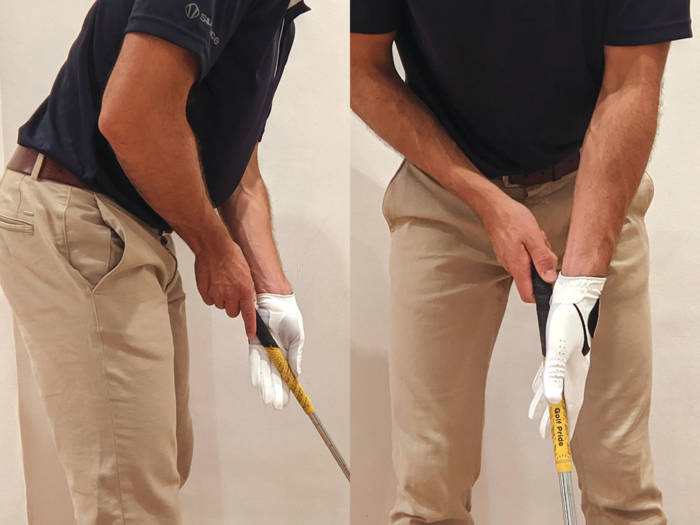
Step 3. When the grip is aligned, wrap your fingers of your left hand around the club, you’ll want to keep them in a fairly relaxed manner. Leave about 1/2 an inch to an inch of the golf grip above your hand – you don’t want to be too close to the edge.
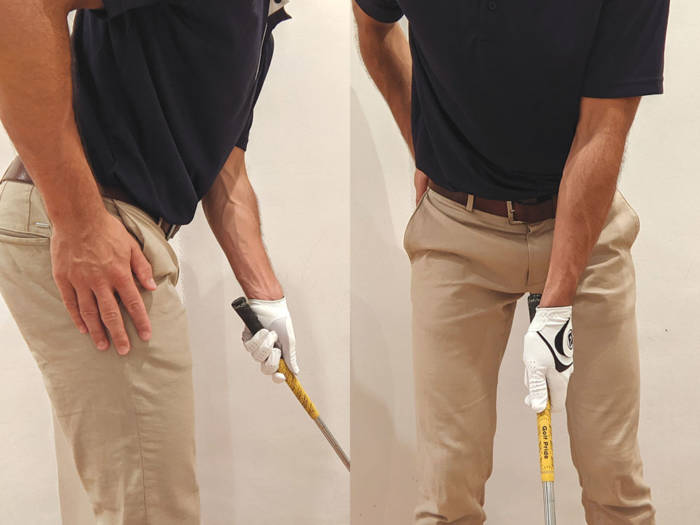
Step 4. For a neutral grip, rotate your non-dominant hand until you can see the two knuckles when you look down. Any more will be a weak grip and less than two knuckles will be a strong grip. Allow your thumb to rest down the centre of the grip on top.
Step 5. Position the base of your right (dominant) hand on top of your left thumb, so it covers it completely. Close your right hand so that your thumb and index finger create a ‘V’ pointing to the middle of your chest. Finally wrap the fingers of your dominant hand under the club.
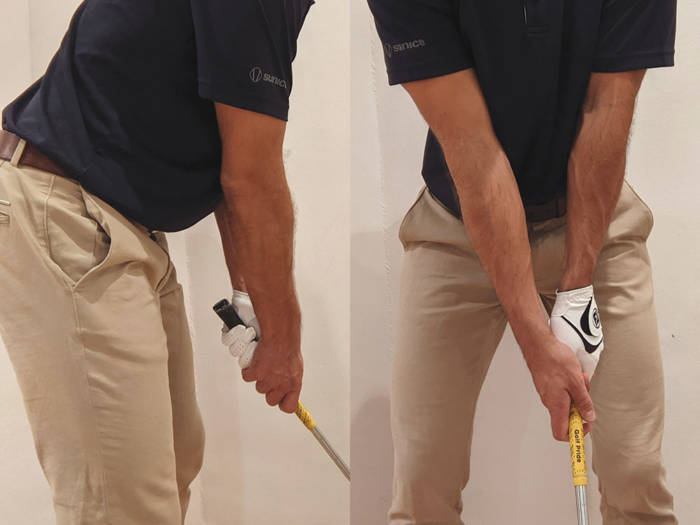
Notice how the hands are very close together so they sit as one unit. This is key to a good swing as it allows you to apply the force to the club from one point rather than two, which can fight against each other in the swing.
If you’ve properly gripped the club you should be able to feel all three of your lower fingers from your right hand making good contact with the grip of the club. But you may be wondering where to position your little finger? That’s where the different types of grips come in, as golfers have different individual preferences.
10 finger grip
The 10 finger grip or “baseball grip” as it’s commonly referred to is a popular choice for beginners or those with arthritis as it’s a little more comfortable. It can also be a good option for those with smaller hands.

The grip leaves minimal space between the two hands and mimics the type of grip used on a baseball bat. No interlocking of the fingers should be used, and typically you’ll have to hold the club towards the middle of the club’s grip area to allow your hands to fit.
Whilst the hands are close, the disadvantage of this grip is that it creates a little more separation between the two hands than the other options, which can lead to a little more inconsistency.
Overlapping grip
Another grip type is overlapping grip, or the “Vardon” grip.
This is probably the most common grip type in golf and involves placing the little finger of your right (dominant) hand and laying it on top of the fingers of the left (non-dominant) hand. It typically sits on top of the index finger of the offhand or in the space between the middle finger and index finger of the offhand.
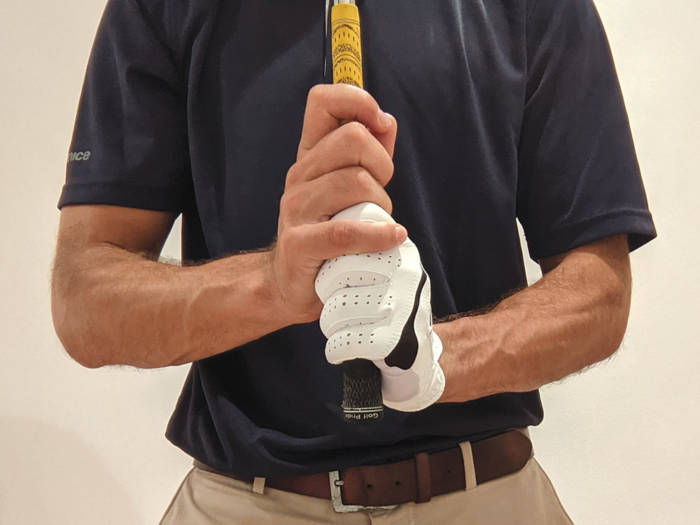
This is a common grip for players with large hands. Golfers with larger hands may also want to consider using some oversized grips which can help provide more consistency.
Interlocking grip
Finally, there is the interlocking grip. This is very similar to the overlapping grip, but as the name suggests, it involves interlocking the little finger of your right hand and index finger of your left hand (instead of resting one on top of the other), linking the hands a little more securely together.
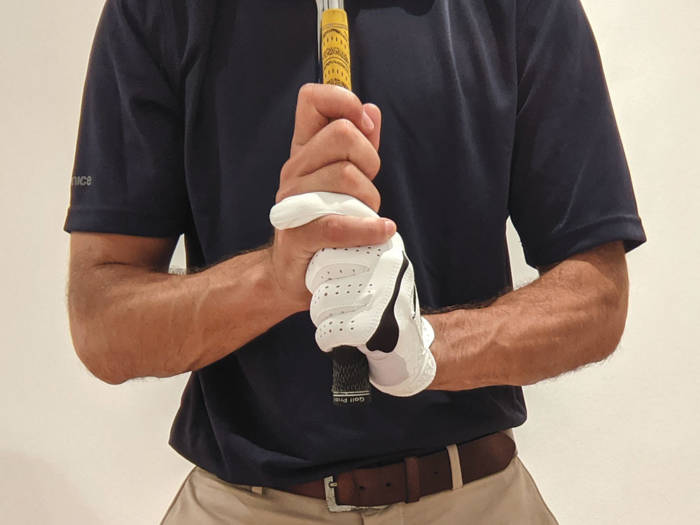
There’s no right or wrong answer, the type of grip you choose is really a matter of preference and depends on what’s comfortable and effective for you.
A word on Grip Strength
The amount of grip you apply when golfing is very situational and can affect your shots a lot. For short shots where accuracy is important, try to go for a more relaxed, delicate grip and allow the club to breeze through the air.
For shots where more power is required, don’t be afraid to grip a little harder – but be aware that over gripping the club can have a huge effect on the trajectory of your long shots and can cause hooking particularly when driving off the tee!